Climate Change and Economic Growth
VerifiedAdded on 2023/04/22
|15
|3534
|365
AI Summary
This document discusses the relationship between climate change and economic growth, the economic cost of climate change, control measures of greenhouse gas emissions, and the role of carbon taxes in adjusting global warming. It also explores the Kyoto Protocol and the Paris Agreement.
Contribute Materials
Your contribution can guide someone’s learning journey. Share your
documents today.

Running head: ECONOMICS
Economics
Name of the student
Name of the university
Author note
Economics
Name of the student
Name of the university
Author note
Secure Best Marks with AI Grader
Need help grading? Try our AI Grader for instant feedback on your assignments.
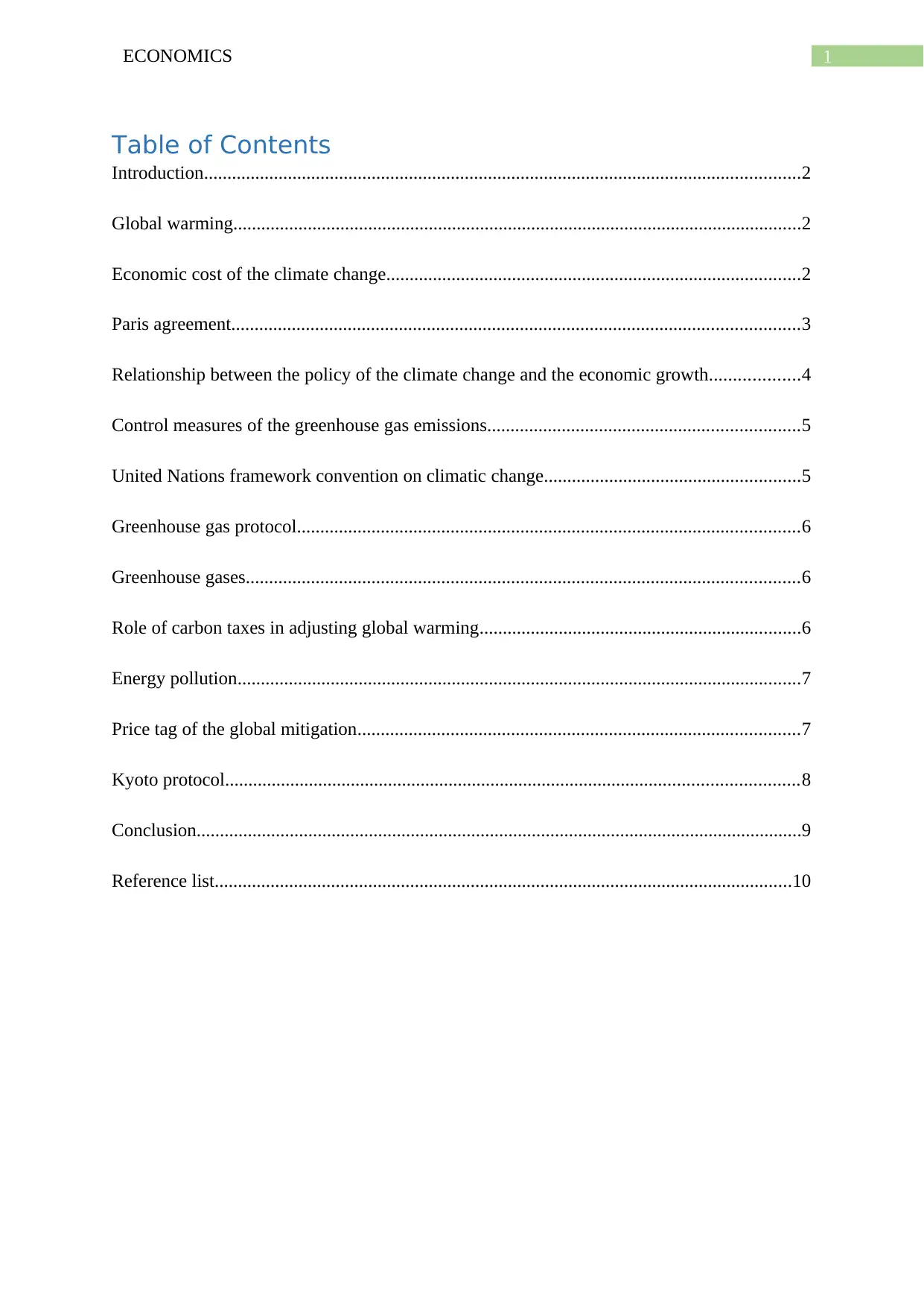
1ECONOMICS
Table of Contents
Introduction................................................................................................................................2
Global warming..........................................................................................................................2
Economic cost of the climate change.........................................................................................2
Paris agreement..........................................................................................................................3
Relationship between the policy of the climate change and the economic growth...................4
Control measures of the greenhouse gas emissions...................................................................5
United Nations framework convention on climatic change.......................................................5
Greenhouse gas protocol............................................................................................................6
Greenhouse gases.......................................................................................................................6
Role of carbon taxes in adjusting global warming.....................................................................6
Energy pollution.........................................................................................................................7
Price tag of the global mitigation...............................................................................................7
Kyoto protocol...........................................................................................................................8
Conclusion..................................................................................................................................9
Reference list............................................................................................................................10
Table of Contents
Introduction................................................................................................................................2
Global warming..........................................................................................................................2
Economic cost of the climate change.........................................................................................2
Paris agreement..........................................................................................................................3
Relationship between the policy of the climate change and the economic growth...................4
Control measures of the greenhouse gas emissions...................................................................5
United Nations framework convention on climatic change.......................................................5
Greenhouse gas protocol............................................................................................................6
Greenhouse gases.......................................................................................................................6
Role of carbon taxes in adjusting global warming.....................................................................6
Energy pollution.........................................................................................................................7
Price tag of the global mitigation...............................................................................................7
Kyoto protocol...........................................................................................................................8
Conclusion..................................................................................................................................9
Reference list............................................................................................................................10
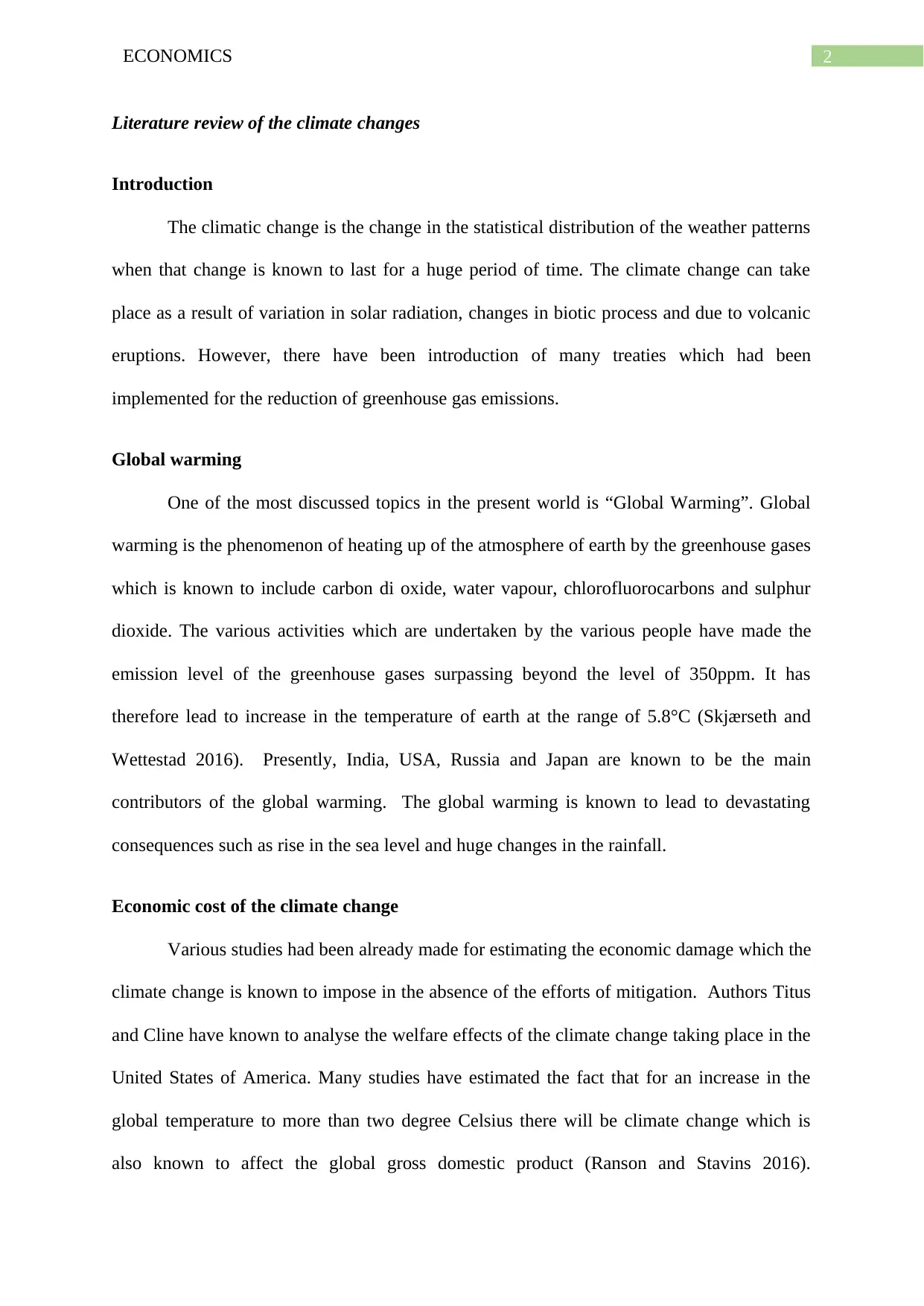
2ECONOMICS
Literature review of the climate changes
Introduction
The climatic change is the change in the statistical distribution of the weather patterns
when that change is known to last for a huge period of time. The climate change can take
place as a result of variation in solar radiation, changes in biotic process and due to volcanic
eruptions. However, there have been introduction of many treaties which had been
implemented for the reduction of greenhouse gas emissions.
Global warming
One of the most discussed topics in the present world is “Global Warming”. Global
warming is the phenomenon of heating up of the atmosphere of earth by the greenhouse gases
which is known to include carbon di oxide, water vapour, chlorofluorocarbons and sulphur
dioxide. The various activities which are undertaken by the various people have made the
emission level of the greenhouse gases surpassing beyond the level of 350ppm. It has
therefore lead to increase in the temperature of earth at the range of 5.8°C (Skjærseth and
Wettestad 2016). Presently, India, USA, Russia and Japan are known to be the main
contributors of the global warming. The global warming is known to lead to devastating
consequences such as rise in the sea level and huge changes in the rainfall.
Economic cost of the climate change
Various studies had been already made for estimating the economic damage which the
climate change is known to impose in the absence of the efforts of mitigation. Authors Titus
and Cline have known to analyse the welfare effects of the climate change taking place in the
United States of America. Many studies have estimated the fact that for an increase in the
global temperature to more than two degree Celsius there will be climate change which is
also known to affect the global gross domestic product (Ranson and Stavins 2016).
Literature review of the climate changes
Introduction
The climatic change is the change in the statistical distribution of the weather patterns
when that change is known to last for a huge period of time. The climate change can take
place as a result of variation in solar radiation, changes in biotic process and due to volcanic
eruptions. However, there have been introduction of many treaties which had been
implemented for the reduction of greenhouse gas emissions.
Global warming
One of the most discussed topics in the present world is “Global Warming”. Global
warming is the phenomenon of heating up of the atmosphere of earth by the greenhouse gases
which is known to include carbon di oxide, water vapour, chlorofluorocarbons and sulphur
dioxide. The various activities which are undertaken by the various people have made the
emission level of the greenhouse gases surpassing beyond the level of 350ppm. It has
therefore lead to increase in the temperature of earth at the range of 5.8°C (Skjærseth and
Wettestad 2016). Presently, India, USA, Russia and Japan are known to be the main
contributors of the global warming. The global warming is known to lead to devastating
consequences such as rise in the sea level and huge changes in the rainfall.
Economic cost of the climate change
Various studies had been already made for estimating the economic damage which the
climate change is known to impose in the absence of the efforts of mitigation. Authors Titus
and Cline have known to analyse the welfare effects of the climate change taking place in the
United States of America. Many studies have estimated the fact that for an increase in the
global temperature to more than two degree Celsius there will be climate change which is
also known to affect the global gross domestic product (Ranson and Stavins 2016).
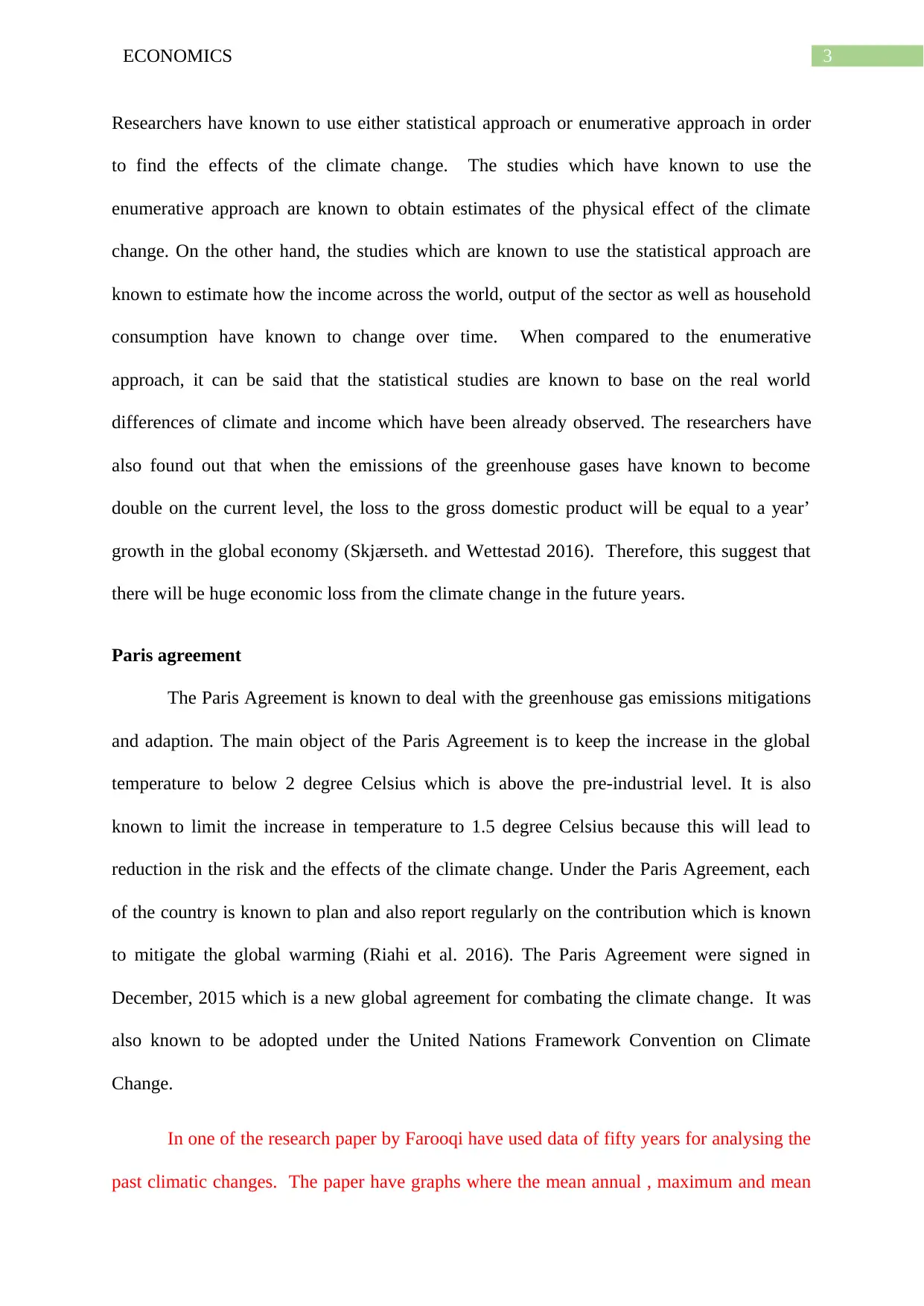
3ECONOMICS
Researchers have known to use either statistical approach or enumerative approach in order
to find the effects of the climate change. The studies which have known to use the
enumerative approach are known to obtain estimates of the physical effect of the climate
change. On the other hand, the studies which are known to use the statistical approach are
known to estimate how the income across the world, output of the sector as well as household
consumption have known to change over time. When compared to the enumerative
approach, it can be said that the statistical studies are known to base on the real world
differences of climate and income which have been already observed. The researchers have
also found out that when the emissions of the greenhouse gases have known to become
double on the current level, the loss to the gross domestic product will be equal to a year’
growth in the global economy (Skjærseth. and Wettestad 2016). Therefore, this suggest that
there will be huge economic loss from the climate change in the future years.
Paris agreement
The Paris Agreement is known to deal with the greenhouse gas emissions mitigations
and adaption. The main object of the Paris Agreement is to keep the increase in the global
temperature to below 2 degree Celsius which is above the pre-industrial level. It is also
known to limit the increase in temperature to 1.5 degree Celsius because this will lead to
reduction in the risk and the effects of the climate change. Under the Paris Agreement, each
of the country is known to plan and also report regularly on the contribution which is known
to mitigate the global warming (Riahi et al. 2016). The Paris Agreement were signed in
December, 2015 which is a new global agreement for combating the climate change. It was
also known to be adopted under the United Nations Framework Convention on Climate
Change.
In one of the research paper by Farooqi have used data of fifty years for analysing the
past climatic changes. The paper have graphs where the mean annual , maximum and mean
Researchers have known to use either statistical approach or enumerative approach in order
to find the effects of the climate change. The studies which have known to use the
enumerative approach are known to obtain estimates of the physical effect of the climate
change. On the other hand, the studies which are known to use the statistical approach are
known to estimate how the income across the world, output of the sector as well as household
consumption have known to change over time. When compared to the enumerative
approach, it can be said that the statistical studies are known to base on the real world
differences of climate and income which have been already observed. The researchers have
also found out that when the emissions of the greenhouse gases have known to become
double on the current level, the loss to the gross domestic product will be equal to a year’
growth in the global economy (Skjærseth. and Wettestad 2016). Therefore, this suggest that
there will be huge economic loss from the climate change in the future years.
Paris agreement
The Paris Agreement is known to deal with the greenhouse gas emissions mitigations
and adaption. The main object of the Paris Agreement is to keep the increase in the global
temperature to below 2 degree Celsius which is above the pre-industrial level. It is also
known to limit the increase in temperature to 1.5 degree Celsius because this will lead to
reduction in the risk and the effects of the climate change. Under the Paris Agreement, each
of the country is known to plan and also report regularly on the contribution which is known
to mitigate the global warming (Riahi et al. 2016). The Paris Agreement were signed in
December, 2015 which is a new global agreement for combating the climate change. It was
also known to be adopted under the United Nations Framework Convention on Climate
Change.
In one of the research paper by Farooqi have used data of fifty years for analysing the
past climatic changes. The paper have graphs where the mean annual , maximum and mean
Secure Best Marks with AI Grader
Need help grading? Try our AI Grader for instant feedback on your assignments.

4ECONOMICS
temperatures values for sixty stations have been drawn. In this paper the precipitation data
had been analysed and the trend lines have been drawn with the fitted curves. The clearest
mitigation effort that have been proposed by the Paris Agreement is to keep the global
temperature below 2 degree Celsius. The Paris Agreement have also asked the countries to
realise serious cuts on the emissions.
Issues related to the Paris Agreement
Although, the Paris Agreement known to look good on paper, there are presence of
several issues connected to it. The Paris Agreement had been signed by the people of
western countries where most of the parties is known to oppose the regulations of the global
climatic changes. The huge level of migration can also know to pose political problems and
therefore these political issues are known to become one of the major obstacle towards the
function of the treaty. The situation with the energy sector have also known to become a
complicated issue. Another problem is that there is uncertainty about whether Paris
Agreement constitute a soft law source or hard law source.
Relationship between the policy of the climate change and the economic growth
The rise in the emission of the carbon dioxide and the greenhouse gases have known
to affect the change in the climate which have also lead to intensified weather events with the
rise in the average global temperature. Countries are also known to release national action
plan for the reduction of greenhouse gas and the emission of carbon di oxide. For examining
the relationship between the economic growth of the country and the climate policies, the
researcher have estimated the fixed effects model. The variables for the control variables are
known to differ widely across the countries (Skjærseth and Wettestad 2016). There have been
usage of regression analyses in order to find the relationship between the policy of the
climate change and the economic growth. The objective of the analysis is for improving the
temperatures values for sixty stations have been drawn. In this paper the precipitation data
had been analysed and the trend lines have been drawn with the fitted curves. The clearest
mitigation effort that have been proposed by the Paris Agreement is to keep the global
temperature below 2 degree Celsius. The Paris Agreement have also asked the countries to
realise serious cuts on the emissions.
Issues related to the Paris Agreement
Although, the Paris Agreement known to look good on paper, there are presence of
several issues connected to it. The Paris Agreement had been signed by the people of
western countries where most of the parties is known to oppose the regulations of the global
climatic changes. The huge level of migration can also know to pose political problems and
therefore these political issues are known to become one of the major obstacle towards the
function of the treaty. The situation with the energy sector have also known to become a
complicated issue. Another problem is that there is uncertainty about whether Paris
Agreement constitute a soft law source or hard law source.
Relationship between the policy of the climate change and the economic growth
The rise in the emission of the carbon dioxide and the greenhouse gases have known
to affect the change in the climate which have also lead to intensified weather events with the
rise in the average global temperature. Countries are also known to release national action
plan for the reduction of greenhouse gas and the emission of carbon di oxide. For examining
the relationship between the economic growth of the country and the climate policies, the
researcher have estimated the fixed effects model. The variables for the control variables are
known to differ widely across the countries (Skjærseth and Wettestad 2016). There have been
usage of regression analyses in order to find the relationship between the policy of the
climate change and the economic growth. The objective of the analysis is for improving the

5ECONOMICS
relationship between the changes of the climate policy and the growth of the economy. The
global rates of the emissions of the greenhouse gases are one of the most urgent issues which
the world is facing.
The challenge of International Cooperation
The climate change in the present world is known to pose new threats which need to
be addressed as rapidly as possible. The global warming is also known to be interpreted as
pubic tragedies of the commons (Rogelj et al. 2016). When there is a case of climatic
change, each country is known to release emissions of greenhouse gases in the environment
which is also known to be the common good. The climate is also known to be the public good
from where no one can get excluded.
Control measures of the greenhouse gas emissions
Intergovernmental panel on climate change
The Intergovernmental Panel on climate change (IPCC) is the international body
which is formed by organized by thee members of the World Health Organization and UNEP.
There are presence of scientists who have known to research on the climatic change taking
place worldwide. One of the main objective of the IPCC is to assess the scientific, socio
economic and technical information which is related to the understanding of the climatic
change which is induced by the humans (Skjærseth and Wettestad 2016). The assessment is
known to be based on the published literature. It is known to classify the countries which are
based on the emission s of the carbon di oxide level.
United Nations framework convention on climatic change
The United Nation framework convention on the climatic change is the international
environmental treaty which is known to be negotiated at the United Nations Conference on
environment and development. The main objective of the treaty is to stabilize the greenhouse
relationship between the changes of the climate policy and the growth of the economy. The
global rates of the emissions of the greenhouse gases are one of the most urgent issues which
the world is facing.
The challenge of International Cooperation
The climate change in the present world is known to pose new threats which need to
be addressed as rapidly as possible. The global warming is also known to be interpreted as
pubic tragedies of the commons (Rogelj et al. 2016). When there is a case of climatic
change, each country is known to release emissions of greenhouse gases in the environment
which is also known to be the common good. The climate is also known to be the public good
from where no one can get excluded.
Control measures of the greenhouse gas emissions
Intergovernmental panel on climate change
The Intergovernmental Panel on climate change (IPCC) is the international body
which is formed by organized by thee members of the World Health Organization and UNEP.
There are presence of scientists who have known to research on the climatic change taking
place worldwide. One of the main objective of the IPCC is to assess the scientific, socio
economic and technical information which is related to the understanding of the climatic
change which is induced by the humans (Skjærseth and Wettestad 2016). The assessment is
known to be based on the published literature. It is known to classify the countries which are
based on the emission s of the carbon di oxide level.
United Nations framework convention on climatic change
The United Nation framework convention on the climatic change is the international
environmental treaty which is known to be negotiated at the United Nations Conference on
environment and development. The main objective of the treaty is to stabilize the greenhouse

6ECONOMICS
gas concentration in the atmosphere at a level which would be preventing interference with
the climatic system. The developed countries are also known to ask to reduce their emissions
at such a level which would be helping the developing nations for attaining the low level of
emission. Therefore, the United Nations framework convention on the climatic change is
known to achieve this particular objective in such a way which will not be affecting the
growth of the economy of the member countries.
Figure 1Share of global carbon di oxide emission
gas concentration in the atmosphere at a level which would be preventing interference with
the climatic system. The developed countries are also known to ask to reduce their emissions
at such a level which would be helping the developing nations for attaining the low level of
emission. Therefore, the United Nations framework convention on the climatic change is
known to achieve this particular objective in such a way which will not be affecting the
growth of the economy of the member countries.
Figure 1Share of global carbon di oxide emission
Paraphrase This Document
Need a fresh take? Get an instant paraphrase of this document with our AI Paraphraser

7ECONOMICS
The chart above shows the measures of the cumulative emissions of the carbon di oxide given
as the share of the global total. The chart shows the significant transitions in the global
emissions. By the year of 2015, china will be accounting for 12 percent of the total
cumulative emissions.
Greenhouse gas protocol
The GUG Protocol is known to act as the major accounting tool for the government as
well as for the business organizations of various nations. The GFG Protocol is known to work
with the international members in order to build credible as well as effective programs for
facing e climate change.
Greenhouse gases
The greenhouse gases are those gases which are known to act as the protective barrier
which is known to filter the harmful rays which enters in to the atmosphere. The greenhouse
gases are also known to absorb and reduce the heat which leaves the earth. Some of the
greenhouse gases includes hydro fluorocarbons, chlorofluorocarbons and sulphur
hexafluoride which are known to be artificially produced (Rahman and Kirkman 2015).
However, the rising level of the green house gases are known to cause imbalance in the
atmosphere. As result of increase industrialization, the concentrations of the greenhouse
gases have known to rise to a very high level.
Role of carbon taxes in adjusting global warming
There are presence of man advantages of the carbon tax which is known for regulation
of the global emissions through the control policies. Carbon taxes are like the environmental
tax which is known to correct distortion which arises mainly from the usage of the
environmental services. A carbon tax is known to set on the basis of the carbon content of
the fossil fuel. The carbon tax is the type of tax which is levied on the carbon content of fuels
The chart above shows the measures of the cumulative emissions of the carbon di oxide given
as the share of the global total. The chart shows the significant transitions in the global
emissions. By the year of 2015, china will be accounting for 12 percent of the total
cumulative emissions.
Greenhouse gas protocol
The GUG Protocol is known to act as the major accounting tool for the government as
well as for the business organizations of various nations. The GFG Protocol is known to work
with the international members in order to build credible as well as effective programs for
facing e climate change.
Greenhouse gases
The greenhouse gases are those gases which are known to act as the protective barrier
which is known to filter the harmful rays which enters in to the atmosphere. The greenhouse
gases are also known to absorb and reduce the heat which leaves the earth. Some of the
greenhouse gases includes hydro fluorocarbons, chlorofluorocarbons and sulphur
hexafluoride which are known to be artificially produced (Rahman and Kirkman 2015).
However, the rising level of the green house gases are known to cause imbalance in the
atmosphere. As result of increase industrialization, the concentrations of the greenhouse
gases have known to rise to a very high level.
Role of carbon taxes in adjusting global warming
There are presence of man advantages of the carbon tax which is known for regulation
of the global emissions through the control policies. Carbon taxes are like the environmental
tax which is known to correct distortion which arises mainly from the usage of the
environmental services. A carbon tax is known to set on the basis of the carbon content of
the fossil fuel. The carbon tax is the type of tax which is levied on the carbon content of fuels
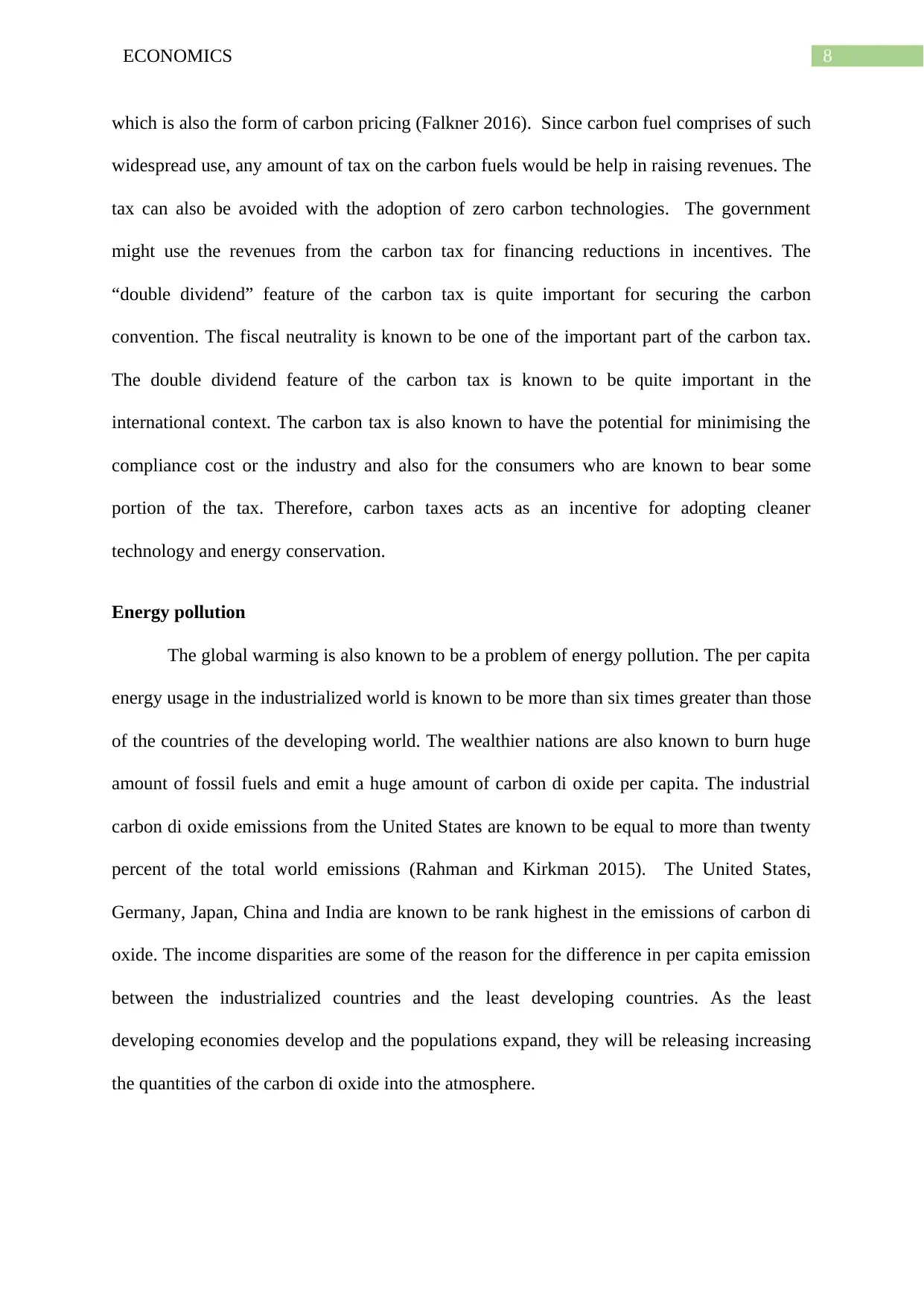
8ECONOMICS
which is also the form of carbon pricing (Falkner 2016). Since carbon fuel comprises of such
widespread use, any amount of tax on the carbon fuels would be help in raising revenues. The
tax can also be avoided with the adoption of zero carbon technologies. The government
might use the revenues from the carbon tax for financing reductions in incentives. The
“double dividend” feature of the carbon tax is quite important for securing the carbon
convention. The fiscal neutrality is known to be one of the important part of the carbon tax.
The double dividend feature of the carbon tax is known to be quite important in the
international context. The carbon tax is also known to have the potential for minimising the
compliance cost or the industry and also for the consumers who are known to bear some
portion of the tax. Therefore, carbon taxes acts as an incentive for adopting cleaner
technology and energy conservation.
Energy pollution
The global warming is also known to be a problem of energy pollution. The per capita
energy usage in the industrialized world is known to be more than six times greater than those
of the countries of the developing world. The wealthier nations are also known to burn huge
amount of fossil fuels and emit a huge amount of carbon di oxide per capita. The industrial
carbon di oxide emissions from the United States are known to be equal to more than twenty
percent of the total world emissions (Rahman and Kirkman 2015). The United States,
Germany, Japan, China and India are known to be rank highest in the emissions of carbon di
oxide. The income disparities are some of the reason for the difference in per capita emission
between the industrialized countries and the least developing countries. As the least
developing economies develop and the populations expand, they will be releasing increasing
the quantities of the carbon di oxide into the atmosphere.
which is also the form of carbon pricing (Falkner 2016). Since carbon fuel comprises of such
widespread use, any amount of tax on the carbon fuels would be help in raising revenues. The
tax can also be avoided with the adoption of zero carbon technologies. The government
might use the revenues from the carbon tax for financing reductions in incentives. The
“double dividend” feature of the carbon tax is quite important for securing the carbon
convention. The fiscal neutrality is known to be one of the important part of the carbon tax.
The double dividend feature of the carbon tax is known to be quite important in the
international context. The carbon tax is also known to have the potential for minimising the
compliance cost or the industry and also for the consumers who are known to bear some
portion of the tax. Therefore, carbon taxes acts as an incentive for adopting cleaner
technology and energy conservation.
Energy pollution
The global warming is also known to be a problem of energy pollution. The per capita
energy usage in the industrialized world is known to be more than six times greater than those
of the countries of the developing world. The wealthier nations are also known to burn huge
amount of fossil fuels and emit a huge amount of carbon di oxide per capita. The industrial
carbon di oxide emissions from the United States are known to be equal to more than twenty
percent of the total world emissions (Rahman and Kirkman 2015). The United States,
Germany, Japan, China and India are known to be rank highest in the emissions of carbon di
oxide. The income disparities are some of the reason for the difference in per capita emission
between the industrialized countries and the least developing countries. As the least
developing economies develop and the populations expand, they will be releasing increasing
the quantities of the carbon di oxide into the atmosphere.
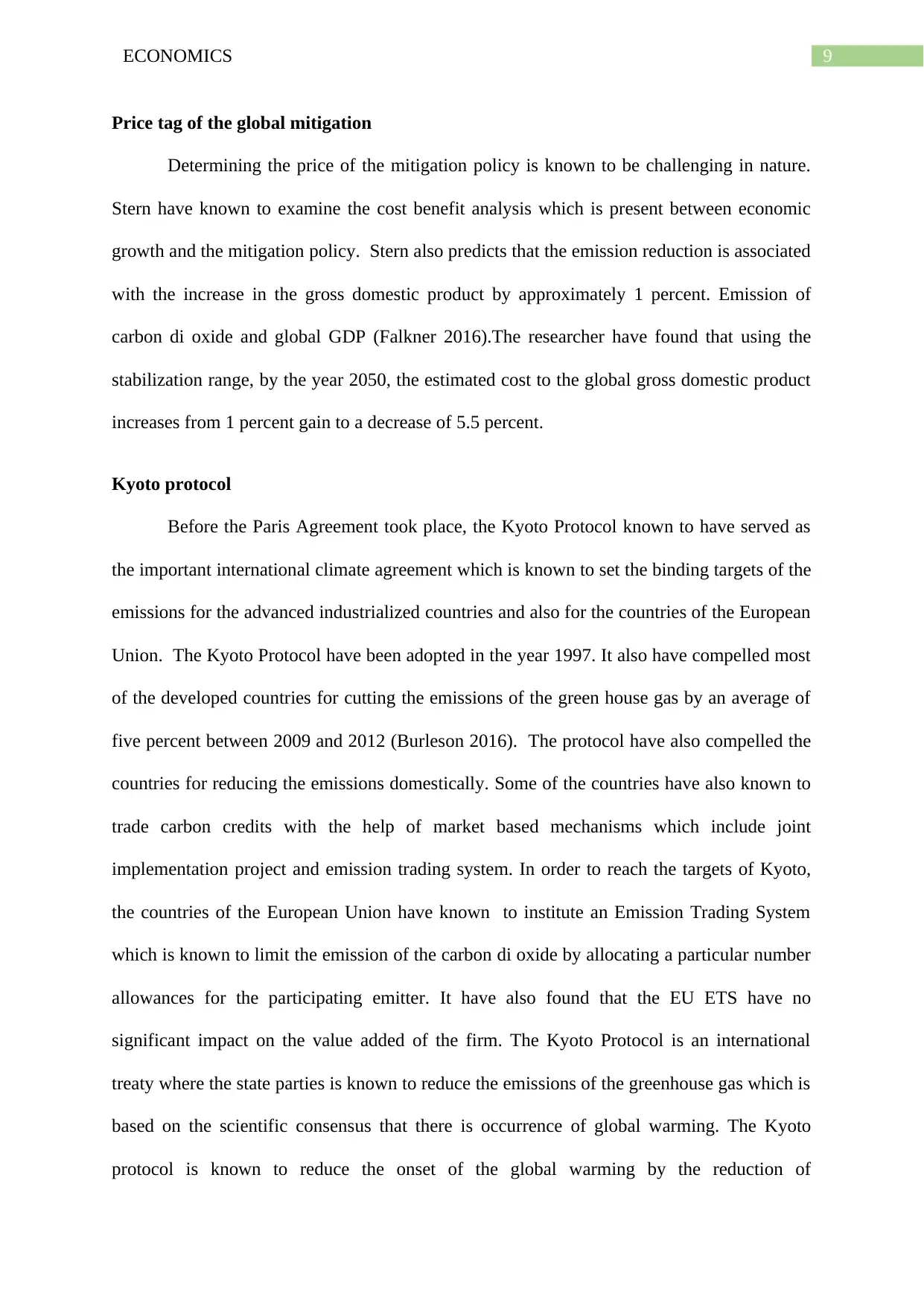
9ECONOMICS
Price tag of the global mitigation
Determining the price of the mitigation policy is known to be challenging in nature.
Stern have known to examine the cost benefit analysis which is present between economic
growth and the mitigation policy. Stern also predicts that the emission reduction is associated
with the increase in the gross domestic product by approximately 1 percent. Emission of
carbon di oxide and global GDP (Falkner 2016).The researcher have found that using the
stabilization range, by the year 2050, the estimated cost to the global gross domestic product
increases from 1 percent gain to a decrease of 5.5 percent.
Kyoto protocol
Before the Paris Agreement took place, the Kyoto Protocol known to have served as
the important international climate agreement which is known to set the binding targets of the
emissions for the advanced industrialized countries and also for the countries of the European
Union. The Kyoto Protocol have been adopted in the year 1997. It also have compelled most
of the developed countries for cutting the emissions of the green house gas by an average of
five percent between 2009 and 2012 (Burleson 2016). The protocol have also compelled the
countries for reducing the emissions domestically. Some of the countries have also known to
trade carbon credits with the help of market based mechanisms which include joint
implementation project and emission trading system. In order to reach the targets of Kyoto,
the countries of the European Union have known to institute an Emission Trading System
which is known to limit the emission of the carbon di oxide by allocating a particular number
allowances for the participating emitter. It have also found that the EU ETS have no
significant impact on the value added of the firm. The Kyoto Protocol is an international
treaty where the state parties is known to reduce the emissions of the greenhouse gas which is
based on the scientific consensus that there is occurrence of global warming. The Kyoto
protocol is known to reduce the onset of the global warming by the reduction of
Price tag of the global mitigation
Determining the price of the mitigation policy is known to be challenging in nature.
Stern have known to examine the cost benefit analysis which is present between economic
growth and the mitigation policy. Stern also predicts that the emission reduction is associated
with the increase in the gross domestic product by approximately 1 percent. Emission of
carbon di oxide and global GDP (Falkner 2016).The researcher have found that using the
stabilization range, by the year 2050, the estimated cost to the global gross domestic product
increases from 1 percent gain to a decrease of 5.5 percent.
Kyoto protocol
Before the Paris Agreement took place, the Kyoto Protocol known to have served as
the important international climate agreement which is known to set the binding targets of the
emissions for the advanced industrialized countries and also for the countries of the European
Union. The Kyoto Protocol have been adopted in the year 1997. It also have compelled most
of the developed countries for cutting the emissions of the green house gas by an average of
five percent between 2009 and 2012 (Burleson 2016). The protocol have also compelled the
countries for reducing the emissions domestically. Some of the countries have also known to
trade carbon credits with the help of market based mechanisms which include joint
implementation project and emission trading system. In order to reach the targets of Kyoto,
the countries of the European Union have known to institute an Emission Trading System
which is known to limit the emission of the carbon di oxide by allocating a particular number
allowances for the participating emitter. It have also found that the EU ETS have no
significant impact on the value added of the firm. The Kyoto Protocol is an international
treaty where the state parties is known to reduce the emissions of the greenhouse gas which is
based on the scientific consensus that there is occurrence of global warming. The Kyoto
protocol is known to reduce the onset of the global warming by the reduction of
Secure Best Marks with AI Grader
Need help grading? Try our AI Grader for instant feedback on your assignments.
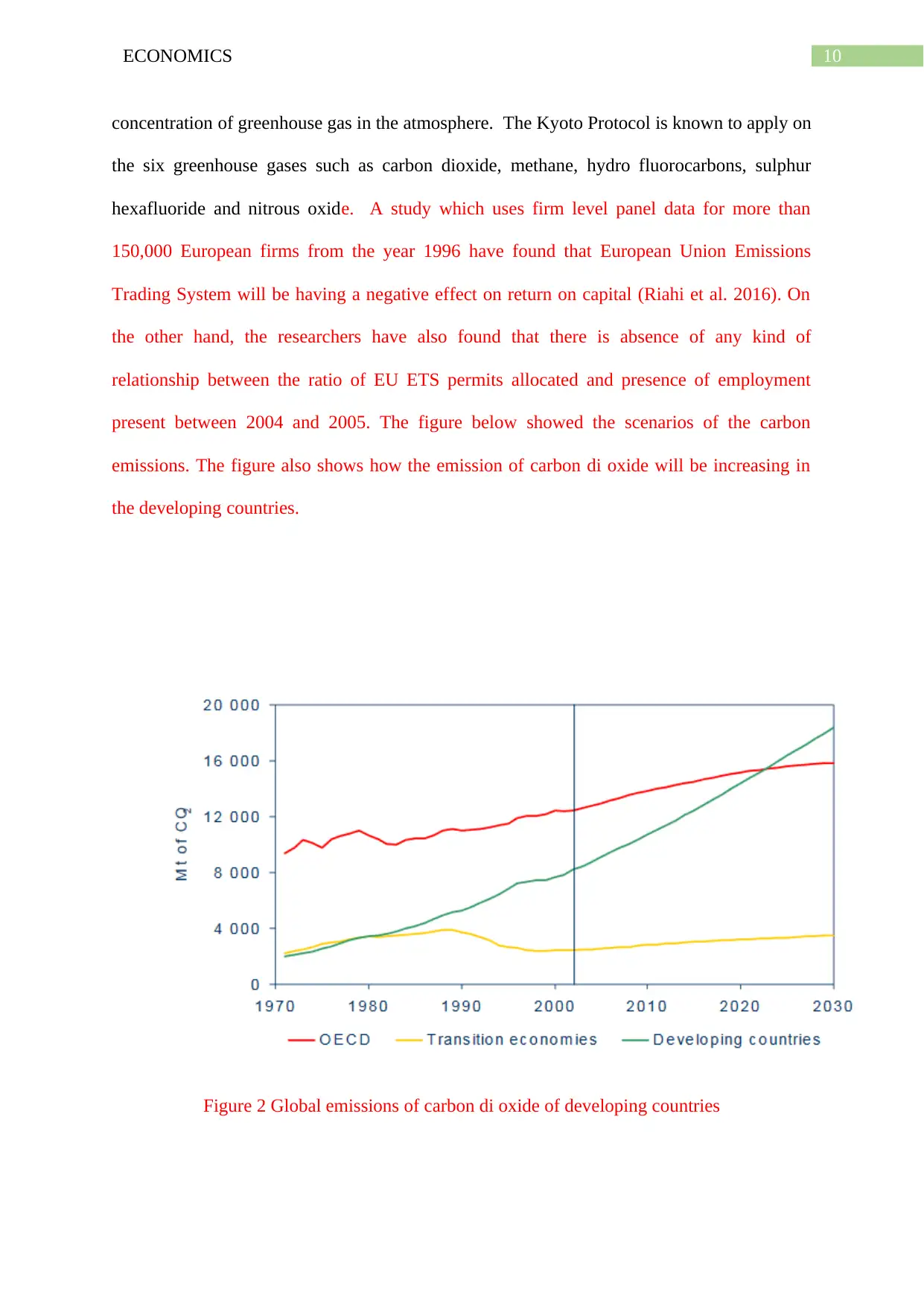
10ECONOMICS
concentration of greenhouse gas in the atmosphere. The Kyoto Protocol is known to apply on
the six greenhouse gases such as carbon dioxide, methane, hydro fluorocarbons, sulphur
hexafluoride and nitrous oxide. A study which uses firm level panel data for more than
150,000 European firms from the year 1996 have found that European Union Emissions
Trading System will be having a negative effect on return on capital (Riahi et al. 2016). On
the other hand, the researchers have also found that there is absence of any kind of
relationship between the ratio of EU ETS permits allocated and presence of employment
present between 2004 and 2005. The figure below showed the scenarios of the carbon
emissions. The figure also shows how the emission of carbon di oxide will be increasing in
the developing countries.
Figure 2 Global emissions of carbon di oxide of developing countries
concentration of greenhouse gas in the atmosphere. The Kyoto Protocol is known to apply on
the six greenhouse gases such as carbon dioxide, methane, hydro fluorocarbons, sulphur
hexafluoride and nitrous oxide. A study which uses firm level panel data for more than
150,000 European firms from the year 1996 have found that European Union Emissions
Trading System will be having a negative effect on return on capital (Riahi et al. 2016). On
the other hand, the researchers have also found that there is absence of any kind of
relationship between the ratio of EU ETS permits allocated and presence of employment
present between 2004 and 2005. The figure below showed the scenarios of the carbon
emissions. The figure also shows how the emission of carbon di oxide will be increasing in
the developing countries.
Figure 2 Global emissions of carbon di oxide of developing countries
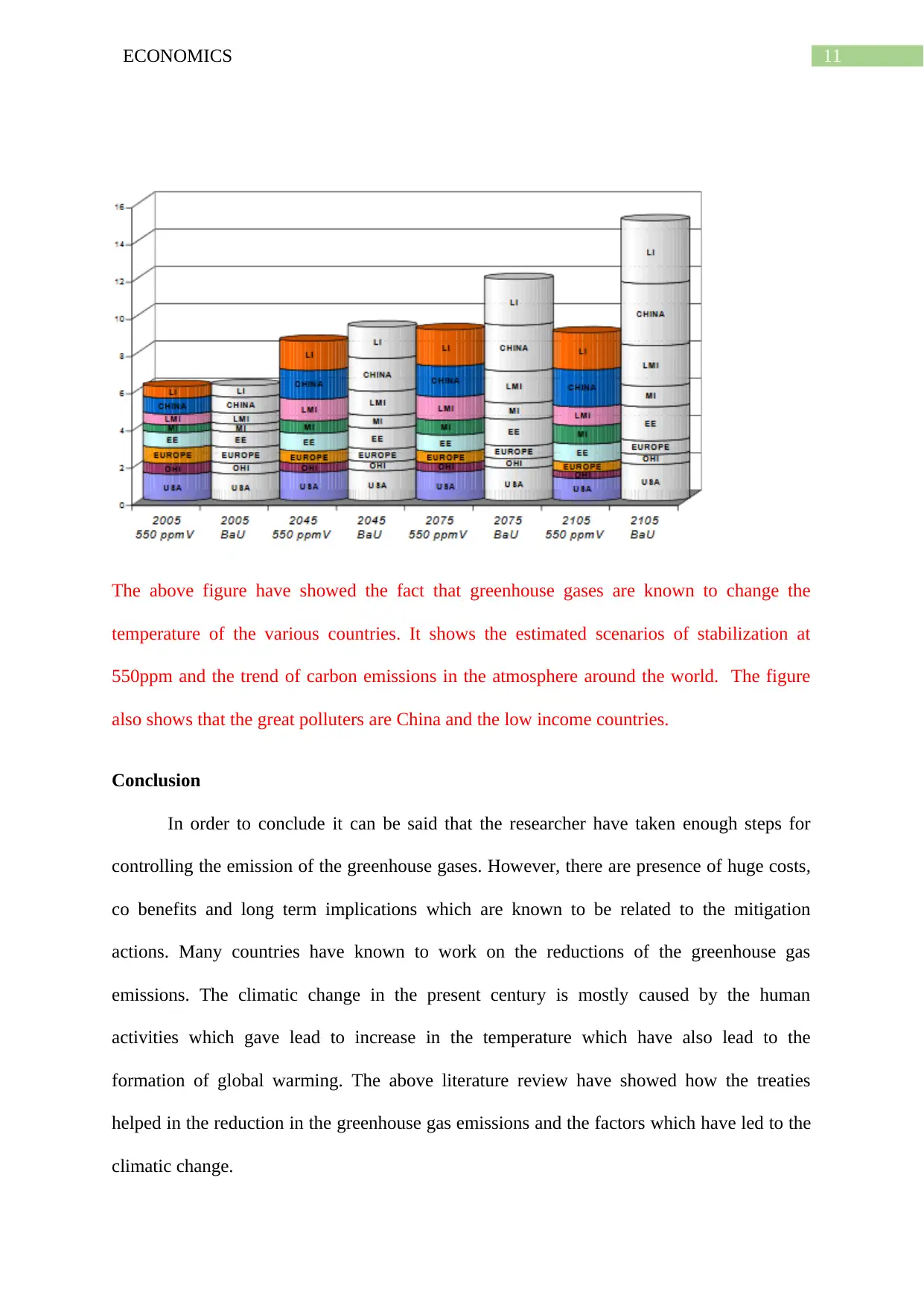
11ECONOMICS
The above figure have showed the fact that greenhouse gases are known to change the
temperature of the various countries. It shows the estimated scenarios of stabilization at
550ppm and the trend of carbon emissions in the atmosphere around the world. The figure
also shows that the great polluters are China and the low income countries.
Conclusion
In order to conclude it can be said that the researcher have taken enough steps for
controlling the emission of the greenhouse gases. However, there are presence of huge costs,
co benefits and long term implications which are known to be related to the mitigation
actions. Many countries have known to work on the reductions of the greenhouse gas
emissions. The climatic change in the present century is mostly caused by the human
activities which gave lead to increase in the temperature which have also lead to the
formation of global warming. The above literature review have showed how the treaties
helped in the reduction in the greenhouse gas emissions and the factors which have led to the
climatic change.
The above figure have showed the fact that greenhouse gases are known to change the
temperature of the various countries. It shows the estimated scenarios of stabilization at
550ppm and the trend of carbon emissions in the atmosphere around the world. The figure
also shows that the great polluters are China and the low income countries.
Conclusion
In order to conclude it can be said that the researcher have taken enough steps for
controlling the emission of the greenhouse gases. However, there are presence of huge costs,
co benefits and long term implications which are known to be related to the mitigation
actions. Many countries have known to work on the reductions of the greenhouse gas
emissions. The climatic change in the present century is mostly caused by the human
activities which gave lead to increase in the temperature which have also lead to the
formation of global warming. The above literature review have showed how the treaties
helped in the reduction in the greenhouse gas emissions and the factors which have led to the
climatic change.

12ECONOMICS
Paraphrase This Document
Need a fresh take? Get an instant paraphrase of this document with our AI Paraphraser
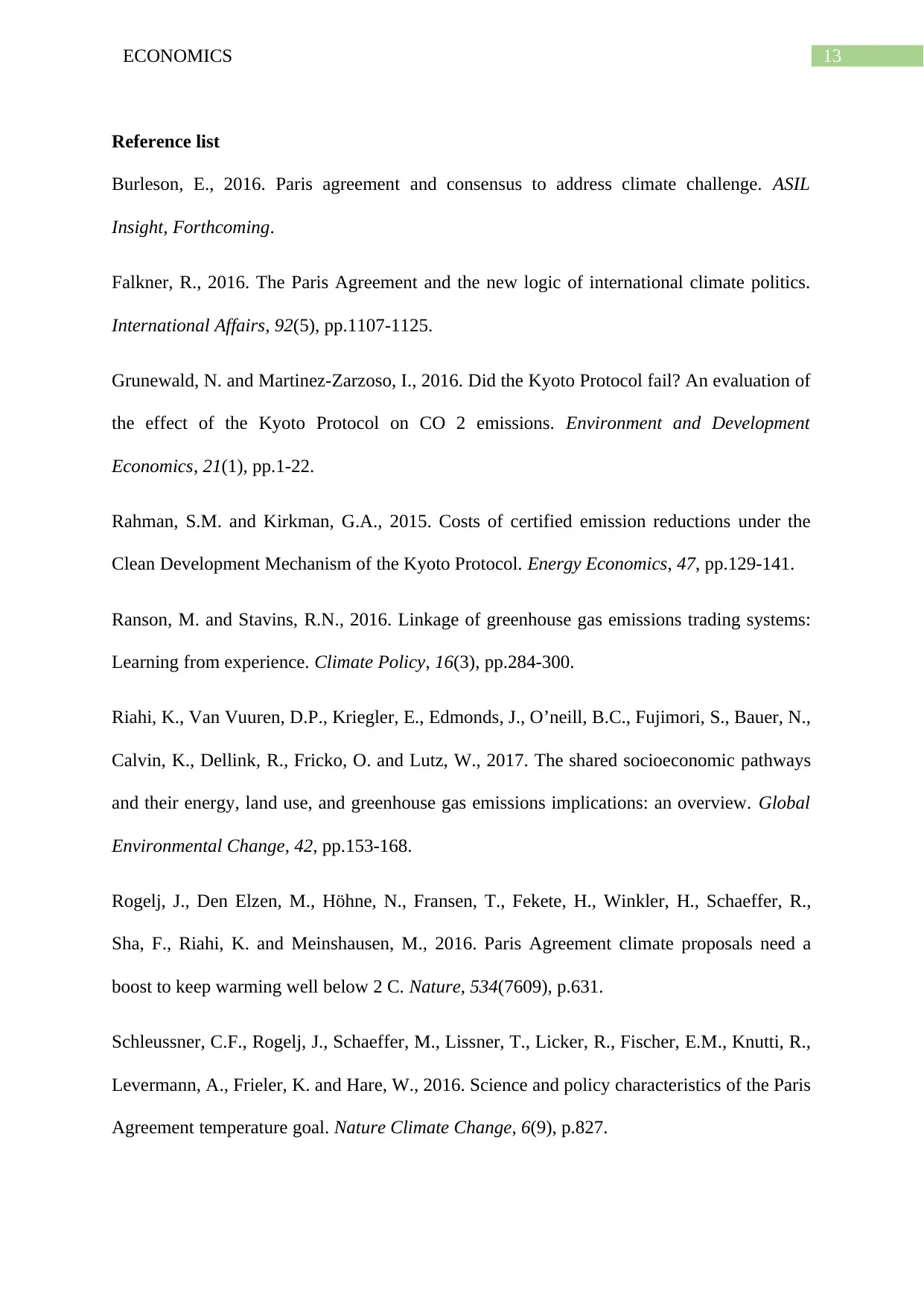
13ECONOMICS
Reference list
Burleson, E., 2016. Paris agreement and consensus to address climate challenge. ASIL
Insight, Forthcoming.
Falkner, R., 2016. The Paris Agreement and the new logic of international climate politics.
International Affairs, 92(5), pp.1107-1125.
Grunewald, N. and Martinez-Zarzoso, I., 2016. Did the Kyoto Protocol fail? An evaluation of
the effect of the Kyoto Protocol on CO 2 emissions. Environment and Development
Economics, 21(1), pp.1-22.
Rahman, S.M. and Kirkman, G.A., 2015. Costs of certified emission reductions under the
Clean Development Mechanism of the Kyoto Protocol. Energy Economics, 47, pp.129-141.
Ranson, M. and Stavins, R.N., 2016. Linkage of greenhouse gas emissions trading systems:
Learning from experience. Climate Policy, 16(3), pp.284-300.
Riahi, K., Van Vuuren, D.P., Kriegler, E., Edmonds, J., O’neill, B.C., Fujimori, S., Bauer, N.,
Calvin, K., Dellink, R., Fricko, O. and Lutz, W., 2017. The shared socioeconomic pathways
and their energy, land use, and greenhouse gas emissions implications: an overview. Global
Environmental Change, 42, pp.153-168.
Rogelj, J., Den Elzen, M., Höhne, N., Fransen, T., Fekete, H., Winkler, H., Schaeffer, R.,
Sha, F., Riahi, K. and Meinshausen, M., 2016. Paris Agreement climate proposals need a
boost to keep warming well below 2 C. Nature, 534(7609), p.631.
Schleussner, C.F., Rogelj, J., Schaeffer, M., Lissner, T., Licker, R., Fischer, E.M., Knutti, R.,
Levermann, A., Frieler, K. and Hare, W., 2016. Science and policy characteristics of the Paris
Agreement temperature goal. Nature Climate Change, 6(9), p.827.
Reference list
Burleson, E., 2016. Paris agreement and consensus to address climate challenge. ASIL
Insight, Forthcoming.
Falkner, R., 2016. The Paris Agreement and the new logic of international climate politics.
International Affairs, 92(5), pp.1107-1125.
Grunewald, N. and Martinez-Zarzoso, I., 2016. Did the Kyoto Protocol fail? An evaluation of
the effect of the Kyoto Protocol on CO 2 emissions. Environment and Development
Economics, 21(1), pp.1-22.
Rahman, S.M. and Kirkman, G.A., 2015. Costs of certified emission reductions under the
Clean Development Mechanism of the Kyoto Protocol. Energy Economics, 47, pp.129-141.
Ranson, M. and Stavins, R.N., 2016. Linkage of greenhouse gas emissions trading systems:
Learning from experience. Climate Policy, 16(3), pp.284-300.
Riahi, K., Van Vuuren, D.P., Kriegler, E., Edmonds, J., O’neill, B.C., Fujimori, S., Bauer, N.,
Calvin, K., Dellink, R., Fricko, O. and Lutz, W., 2017. The shared socioeconomic pathways
and their energy, land use, and greenhouse gas emissions implications: an overview. Global
Environmental Change, 42, pp.153-168.
Rogelj, J., Den Elzen, M., Höhne, N., Fransen, T., Fekete, H., Winkler, H., Schaeffer, R.,
Sha, F., Riahi, K. and Meinshausen, M., 2016. Paris Agreement climate proposals need a
boost to keep warming well below 2 C. Nature, 534(7609), p.631.
Schleussner, C.F., Rogelj, J., Schaeffer, M., Lissner, T., Licker, R., Fischer, E.M., Knutti, R.,
Levermann, A., Frieler, K. and Hare, W., 2016. Science and policy characteristics of the Paris
Agreement temperature goal. Nature Climate Change, 6(9), p.827.
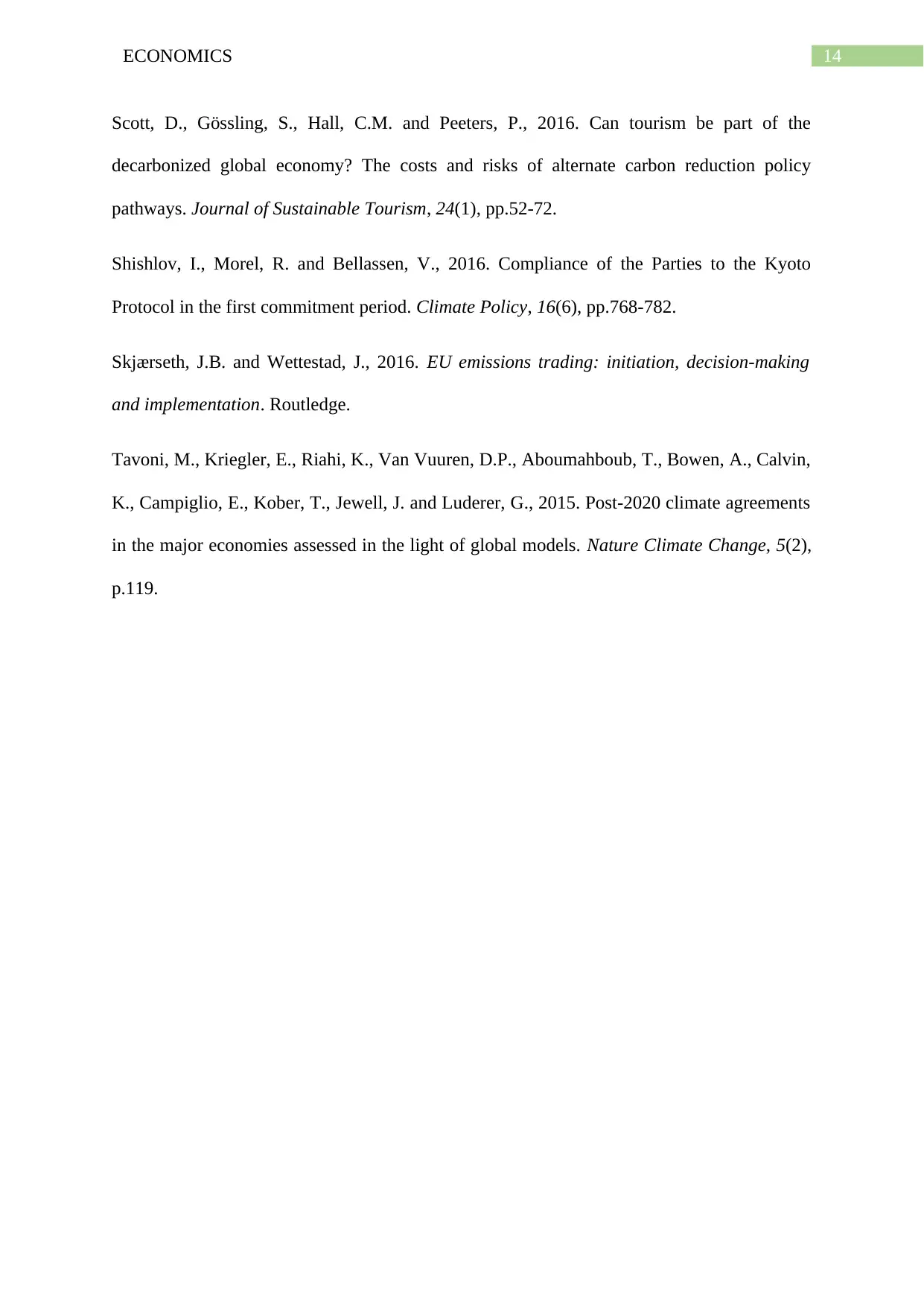
14ECONOMICS
Scott, D., Gössling, S., Hall, C.M. and Peeters, P., 2016. Can tourism be part of the
decarbonized global economy? The costs and risks of alternate carbon reduction policy
pathways. Journal of Sustainable Tourism, 24(1), pp.52-72.
Shishlov, I., Morel, R. and Bellassen, V., 2016. Compliance of the Parties to the Kyoto
Protocol in the first commitment period. Climate Policy, 16(6), pp.768-782.
Skjærseth, J.B. and Wettestad, J., 2016. EU emissions trading: initiation, decision-making
and implementation. Routledge.
Tavoni, M., Kriegler, E., Riahi, K., Van Vuuren, D.P., Aboumahboub, T., Bowen, A., Calvin,
K., Campiglio, E., Kober, T., Jewell, J. and Luderer, G., 2015. Post-2020 climate agreements
in the major economies assessed in the light of global models. Nature Climate Change, 5(2),
p.119.
Scott, D., Gössling, S., Hall, C.M. and Peeters, P., 2016. Can tourism be part of the
decarbonized global economy? The costs and risks of alternate carbon reduction policy
pathways. Journal of Sustainable Tourism, 24(1), pp.52-72.
Shishlov, I., Morel, R. and Bellassen, V., 2016. Compliance of the Parties to the Kyoto
Protocol in the first commitment period. Climate Policy, 16(6), pp.768-782.
Skjærseth, J.B. and Wettestad, J., 2016. EU emissions trading: initiation, decision-making
and implementation. Routledge.
Tavoni, M., Kriegler, E., Riahi, K., Van Vuuren, D.P., Aboumahboub, T., Bowen, A., Calvin,
K., Campiglio, E., Kober, T., Jewell, J. and Luderer, G., 2015. Post-2020 climate agreements
in the major economies assessed in the light of global models. Nature Climate Change, 5(2),
p.119.
1 out of 15
Related Documents
Your All-in-One AI-Powered Toolkit for Academic Success.
+13062052269
info@desklib.com
Available 24*7 on WhatsApp / Email
![[object Object]](/_next/static/media/star-bottom.7253800d.svg)
Unlock your academic potential
© 2024 | Zucol Services PVT LTD | All rights reserved.





